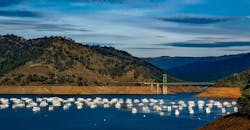California Shuts Down Major Hydroelectric Plant Due to Low Water Levels at Lake Oroville
California shut down a major hydroelectric power plant at Lake Oroville due to water levels falling near the minimum necessary to generate power.
The six-turbine Edward Hyatt Power Plant was taken offline after the water level in the Oroville Dam reservoir that feeds it sank to an historic low of less than 642 feet above mean sea level, reported AP News.
According to state water officials, this is the first time the state has shut down the Hyatt Power Plant due to depleted water levels since the plant went into operation in 1967, reported CNBC.
Even more, the loss of power may fuel more rolling blackouts, adding to the state’s struggles with drought and record-breaking heat waves. The high temperatures and dry soil have significantly reduced water runoff into the reservoirs this spring, according to officials.
According to officials, the record-low water levels at Lake Oroville are a result of the drought that has intensified due to climate change, reported CNBC.
The plant can produce enough power for 80,000 homes and businesses, but “the state has planned for its loss in both water and (electrical) grid management,” said a statement from the state Department of Water Resources, reported AP News.
According to Karla Nemeth, director of the state’s water resources department, the department anticipated the shutdown and planned for a loss of water and grid management, reported CNBC. Officials add that the plant can no longer generate power if water levels fall below 640 feet above sea level. Officials will release some water from the dam to the Feather River to maintain river temperature requirements.
Water elevations at Lake Oroville are forecast to reach as low as 620 feet above sea level by the end of October, according to the California Department of Water Resources.
Four years ago, more than 180,000 people were evacuated after heavy winter storms filled the reservoir and its two spillways collapsed, resulting in a $1 billion repair bill, reported AP News.
Gov. Gavin Newsom recently asked California residents to curb household water consumption by 15% to preserve water supply. Grid operators have also urged residents to limit electricity use to avoid blackouts as wildfires scorch the state, including the Dixie Fire, reported CNBC.
